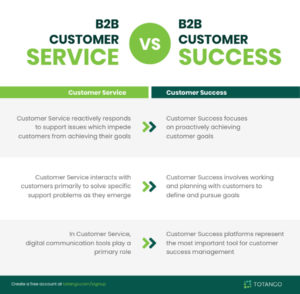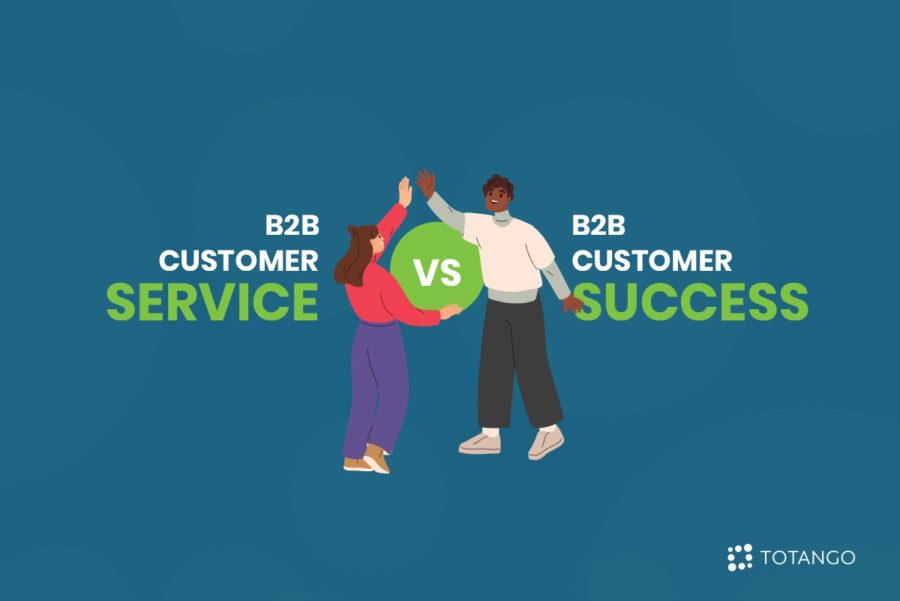B2B customer service is often confused with B2B customer success, but they are not the same. Despite their differences, however, they do share an intimate relationship – you need strong customer service to achieve customer success.
In this article, we’ll take a look at the relationship between these two important ingredients for a successful SaaS business model. First, we’ll define what B2B customer service is and distinguish it from customer support in B2C industries. Then, we’ll consider how B2B customer service differs from customer success in a B2B context. Finally, we’ll explore what B2B customer service and customer success have in common and why you need them to work together to achieve winning SaaS business results.
What is B2B Customer Service?
Business-to-business (B2B) customer service refers to support delivered to clients who are businesses rather than consumers. It includes service delivered before, during and after the purchase process, but most frequently refers to post-purchase service. Common examples of B2B customer service issues that arise in a SaaS context include:
- Billing problems
- Lost passwords
- Software installation and onboarding issues
- Software feature instructions
- App integrations
- Technical bugs
- Server interruptions
- Refund requests
- Upgrades
B2B customer service encompasses service delivered through all support channels, including:
- Help desk software
- Chat
- Texting
- Phone
- Social media
- In-person
B2B customer service may be manual or automated. When delivered manually, it may be handled by dedicated customer service agents or by other company representatives, such as account managers and customer success managers. When delivered through automation, it may deploy tools such as online knowledge bases, chatbots and interactive voice response (IVR) phone systems. Customer success platforms, although designed more specifically for a different purpose, also may serve to assist customer service delivery. For example, the Totango customer success platform can be set up to trigger automated emails for customers experiencing common support issues, providing them with links to relevant tutorials or other helpful information.
B2B vs. B2C Customer Service
B2B customer service generally parallels the type of support delivered by businesses to consumers, known as B2C customer service. However, in detailed application, it can differ in some important ways from consumer support. Differences include:
- B2B customers often have more complex customer service issues than consumer customers, due to factors such as the size of their organizations, the number of departments and personnel involved, the size of their customer base and the scale of their technology usage.
- Because of the complexity of B2B customer service needs, B2B customers may require more dedicated support delivered over a longer period of time.
- B2B customers may represent a greater proportion of a company’s income, making resolution of B2B customer service issues bear more directly on determining a company’s financial performance.
These differences tend to make B2B customer service more resource-intensive than B2C customer service. For B2B companies operating at scale, this may require more advanced use of technology to balance clients’ needs for personalized attention with companies’ needs to manage the limited availability of support personnel. Smart use of automation may become necessary to handle B2B customer needs at scale while still delivering customized support.
What Is the Difference between B2B Customer Service and Customer Success?
Although B2B customer service and B2B customer success are often thought of interchangeably, they are not the same. They have different definitions, purposes, methods and tools.
Defining B2B Customer Success
B2B customer success management is a strategy for promoting outcomes that meet client goals. This is intended to ensure that the client’s experience with your brand aligns with their expectations so that they remain satisfied customers inclined to continue buying from you and promoting your brand to others.
To achieve this goal, customer success teams work with clients to define objectives, develop strategies, implement plans and monitor results. In many cases, a dedicated customer success manager is assigned to an individual customer account. Alternately, customer success automation technology may be used to reduce the amount of one-to-one engagements required of success managers, freeing up staff to focus on situations that truly need manual attention.
Customer success platforms help automate the task of delivering desired outcomes to customers on a consistent basis. Totango’s platform achieves this by combining KPI monitoring with automatically and manually triggered workflows called SuccessPlays, which reflect best practices for specific situations. KPIs are used to define customer objectives and track progress toward corresponding goals. If the platform’s monitoring of KPIs indicates a specific action is required, the software can automatically trigger an action or notify a customer success representative to reach out, as appropriate.
For example, if a customer’s subscription is nearing its expiration date, Totango can automatically monitor and provide relevant account data, such as the customer’s Net Promoter Score (NPS), which is a key indicator of satisfaction and inclination to renew. If a customer’s NPS is low enough to indicate risk of churn, the software can manually notify a success agent to review the account and reach out to the customer in an effort to increase their satisfaction before renewal approaches. On the other hand, customers with a high NPS score may receive an automated upsell invitation as part of their renewal offer.
B2B Customer Success vs. B2B Customer Service
The mission, method and tools that define B2B customer success make it stand out from B2B customer service in some notable ways:
- Customer success focuses on proactively achieving customer goals rather than reactively responding to support issues that impede customers from achieving their goals.
- Customer success involves working and planning with customers to define and pursue goals, whereas customer service interacts with customers primarily to solve specific support problems as they emerge.
- Customer success platforms represent the most important tool for customer success management with digital communication tools playing a supporting role, whereas for customer service, digital communication tools play a primary role.
These differences help make B2B customer success a distinct enterprise from B2B customer service.
Commonalities between B2B Customer Service and Customer Success
While B2B customer success and service differ, they also share a common goal of serving customers, which creates some overlap between their methods, tools and best practices. A strong customer success strategy can help pre-empt many customer service issues, while good customer service can remove barriers that hinder customer success. Here are some best practices that B2B customer success and customer service have in common.
1. Place Customers at the Forefront Internally
Effective customer success management and good customer service both stem from a company culture that places customers at the forefront. Build a custom-centric focus into your mission statement, standard operating procedures and staff training. Make sure that your team understands the importance of customer feedback and adheres to policies that promote customer service and success.
2. Use Customer Data Effectively
Being customer-centric means paying attention to customer data. Key performance indicators tell you vital information about your customers by providing you with vast amounts of data you can analyze to make better decisions and provide more personalized attention. Harness your data to keep customers on track towards their success goals as well as to provide them with better service.
3. Create a Process to Obtain Quality Customer Feedback
Feedback in your customers’ own words can enhance the insights you gain from monitoring customer data. Create processes that enable you to obtain quality customer feedback. For example, you can use your customer journey map to identify key points in your customer lifecycle to administer surveys, such as immediately post-purchase, after the first 30 days of usage and after a customer service ticket has been resolved.
4. Make It Easy for Customers to Speak to Real People
Customers are more able and willing to provide feedback when they’re able to reach you. On the other hand, nothing is more frustrating to customers than needing to speak to a live person and being unable to reach a real human being. Make sure your customers can get human help when they need it by combining strategic automation with procedures that make it easy for customers to get ahold of a live support or service representative. Provide multiple communication channels so that customers can use their preferred mode of contacting you. Use tools such as chatbots and IVR in combination with customer data to pre-empt the majority of support issues, but build in the ability for your automation system to detect when a customer needs to be referred to a live agent. This approach frees up your staff by letting automation do the heavy lifting while reserving your team’s time for tickets that need a human touch.
5. Build Effective Systems to Implement Customer Feedback
To put customer feedback to practical use, incorporate it into self-perpetuating, end-to-end feedback loops. Use the information you gather from customers to inform your product development, and shape upgrades and new products into conformity with customer needs and input. Then, let customers know how you incorporated their feedback through announcements and personalized messages. This will invite ongoing feedback, helping you better serve your customers by continually improving and optimizing your product.
Integrate Your B2B Customer Service into a Winning Customer Success Strategy
 B2B customer service is support delivered to business clients during any phase of the customer lifecycle using any communication channel through either manual or automated means. It differs from B2B customer success management, which is geared toward proactively delivering desired outcomes for clients rather than reactively responding to support issues. However, customer service and success both revolve around serving the customer and they share best practices that mutually support one another.
B2B customer service is support delivered to business clients during any phase of the customer lifecycle using any communication channel through either manual or automated means. It differs from B2B customer success management, which is geared toward proactively delivering desired outcomes for clients rather than reactively responding to support issues. However, customer service and success both revolve around serving the customer and they share best practices that mutually support one another.
Commonalities between customer success and service include adopting a customer-centric company culture, incorporating customer data and feedback and making it easy for customers to reach live representatives. Customer success management and service can both benefit from customer success platform technology, which uses tools such as KPIs and automatically triggered workflows to promote customer goals and pre-empt service issues.
Totango’s customer success platform provides KPIs and automated workflows to support effective B2B customer service and promote client satisfaction. Try it free to see how the right customer success technology can help you deliver better customer service and more satisfying outcomes for your clients.

